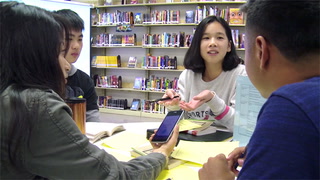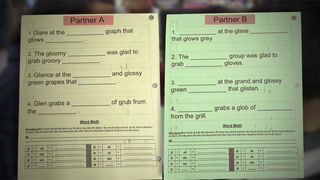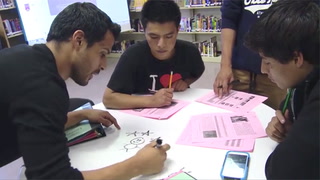Split Dictation Activity Transcript
Speaker 1: I use the strategy of split dictation to help students build their auditory comprehension around listening to words in English and also their pronunciation around practicing the consonant blends or the phonemic awareness skills or awareness skills that we are working on for that day. To both assess how they are growing in that area and also give them easy structure to engage with a partner in English and exchange ideas.
Partner A, you are going to read all four sentences to Partner B.
So the structure is there is a yellow paper, who's Partner A and a green paper who is Partner B. They have the same text but they're missing different words.
And you're going to put your binder up so your partner cannot see.
Partner B will listen for the words that are blank on their paper and write them down as they hear them; and then they switch and repeat that same structure.
What are some things we should be asking our partner if we do not understand?
Speaker 2: Can you spell?
Speaker 1: Can you spell?
Speaker 3: Can you repeat?
Speaker 1: Can you repeat?
Speaker 4: How do you say?
Speaker 1: And how do you say? Very good. Please encourage, please tell your partner to say these things if they do not understand. Partner A, you have 4 minutes. Go!
Speaker 5: The gloomy plane was [inaudible 00:01:19] ...
Speaker 6: Gloomy. How do you spell 'Gloomy'?
Speaker 5: G-l...[crosstalk 00:01:26]
Speaker 1: For myself, I get to walk around and hear students practice the phonics skill for the day and asses "Are they actually getting it?" I also kind of cross reference that with their actual papers.
Speaker 7: Grap-es.
Speaker 1: Can you repeat this one?
Speaker 7: Grap-ees.
Speaker 1: Grapes.
Speaker 7: Grapes.
Speaker 1: Remember, it's the 'E,' right? So it's silent. Grapes.
Speaker 7: Grapes.
Speaker 1: In terms of students working together, it's a way for them just to both self-assess and asses other students' growth.
Speaker 8: You got it?
Speaker 9: Yes.
Speaker 1: If you are done, please switch. 5 more minutes.
Speaker 10: And the glossy green grapes.
Speaker 11: Yeah, uh-huh.
Speaker 6: [inaudible 00:02:05] grabbed a block ...
Speaker 5: How do you spell [inaudible 00:02:07]?
Speaker 6: G-n-o-b.
Speaker 5: 'B'?
Speaker 1: Can you repeat?
Speaker 12: G- Groin.
Speaker 1: Grab.
Speaker 12: Grab. Okay.
Speaker 1: Derone, can you say this?
Speaker 12: Can you spell?
Speaker 1: 'G' ...
Speaker 12: 'G' ...
Speaker 1: 'R'...
It's hard to teach phonics to students in high school. And for adults, phonics can seem, you know, really boring.
Speaker 12: [crosstalk 00:02:33]
Speaker 1: So it's a short, simple structure; it's adult friendly.
2 more minutes.
They love it, they know it's a time thing, where it's kind of competition around like "I wanna pronounce these sentences and read them out loud."
Speaker 12: 'B' or 'V'?
Speaker 13: 'B', 'B'.
Speaker 14: Finished.
Speaker 1: And it's a way for them to work together, to feel confident speaking in English. And helping one another grow in English.
















6 Comments
Lan Pham Apr 20, 2020 6:11pm
This activity could benefit ELL students in their listening skills by listening to their partners to get details or specific information. Also, they need to ask for repeating or spelling the words if they cannot get the words. In this way, both students can improve their listening skills.
2. How does this activity help students improve their pronunciation?
It is always necessary to help ELL students improve their pronunciation no matter what grades they are in. This activity is an effective way for them to improve phonemic awareness skills and learn how to decode words. In this video, the teacher is trying to help them work with consonant blends in an active way, through which the students will improve their pronunciation and build their speaking and listening skills.
3. |Why is this strategy effective for high school ELL students?
Teaching pronunciation using this strategy is absolutely appropriate and effective for high school ELL students. This kind of pronunciation exercise keeps them engaged in the classroom activity and build their confidence in speaking and learning skills. Auditory learners at the high school level might feel bored if the teacher gives them a pronunciation lesson separately.
Jacqueline Fix Jun 5, 2017 7:17pm
Cyndi Hernandez Jan 11, 2021 1:20pm
Thank you, Jacqueline for the answer to this question.
Liz Evans Jun 5, 2017 2:26pm
Jude Thaddaeus ... May 27, 2017 12:06pm
Betty Arteaga-Soto May 17, 2017 9:13pm